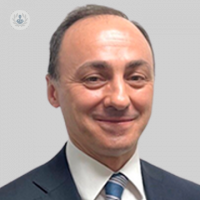Gastroscopy: everything you need to know
Autore:Consultant general, laparoscopic and benign upper GI surgeon Mr Ricardo Camprodon provides all the information you need to know about gastroscopy, reassuring you about any worries that you may have.
What is gastroscopy?
A gastroscopy is, in essence, a flexible tube with a camera at the end, used to assess your gullet or food pipe, the stomach and the very beginning of the small bowel (the duodenum).
When is a gastroscopy necessary?
There are a number of indications for a gastroscopy. If you’re looking for cancers, you should look out for symptoms such as:
- Pain or difficulty in swallowing.
- Indigestion.
- Heartburn.
- Pain, particularly epigastric pain.

It may also be necessary in the following cases:
- If you have a persistent feeling of sickness (nausea) or vomiting.
- When you have weight loss with no other obvious reason.
- When you have sticky black poo, (particularly true for those patients that have suffered from peptic ulcer disease in the past or that they may have risks of peptic ulcer disease).
- To take biopsies for diagnosis.
- To treat patients that may have some narrowings with stretch.
A gastroscopy could be used also to remove growths or polyps, to stop bleeding or to assess the response of any treatment, particularly if patients have suffered or are suffering from significant inflammation of the gullet, the stomach or the duodenum.
Furthermore, it could also be used to place stents for patients that suffer from significant structuring, whether it is benign or malignant. As a result of this, patients can eat/ resume their food intake. For patients that cannot eat, certain types of feeding tubes can be placed into the stomach or into the small bowel to help them nutritionally.
How should a patient prepare when they're facing a gastroscopy?
The doctor will brief the patient before the procedure, during which they will explain to patients what their expectations may be.
The procedure is very safe and extremely short, lasting just 5 to 10 minutes. Prior to this, the patient will receive a leaflet from the hospital, giving advice on how to prepare for the procedure, such as when to stop eating, (no less than six hours before the procedure), except for those patients that have some other morbidities, such as diabetes and which medications should they should stop.
Stopping medication is particularly important for those patients that are on blood thinners, who may require biopsies or other treatments which require them to stop their medication. However, most can continue taking their medication.
What happens during the procedure?
Patients can opt for a throat spray, but if they feel a bit anxious or apprehensive about the procedure, they can have conscious sedation, to make them relax, to able to withstand the procedure better and have a better experience.
As previously mentioned, it is an extremely quick and safe procedure, which only lasts 5 to 10 minutes at the most, but it can be unpleasant, particularly when the scalp rubs the back of the throat. The spray is useful because it numbs the back of the throat.
The procedure is very, very safe. In the majority of cases, patients only experience a sore throat, which can last up to a couple of days.
More serious complications include bleeding, but this is usually rare. Statistics demonstrate that the likelihood of this happening is only one in 3,000. In addition, there is a chance of developing holes in the lining of the gullet, stomach, or small holes in the small bowel. The likelihood of this is even rarer, up to one in 7,000.
What recommendation would you give to a patient undergoing a gastroscopy?
I recommend that the patient is as relaxed as possible while undergoing this procedure because it is very safe and before undergoing the procedure, they will receive a lot of information for patients, making the process for both patients and clinicians.
Patients do not need to worry because it is a very safe procedure.
If you require a gastroscopy and would like to make an appointment with Mr Camprodon, do not hesitate to do so by visiting his Top Doctors profile here today.


